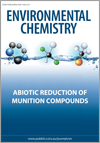Environmental context. There is a growing need to understand how insensitive munitions compounds behave in natural environments, particularly in soils, where non-combusted residues accumulate. Here, we tested the ability of sulfate green rust, a naturally occurring mineral, to transform munitions compounds by reacting with the mineral surface. Our results show that both the munitions compounds and the mineral structures are transformed in an oxidation–reduction reaction that alters the compounds’ environmental fates.

Environmental Chemistry
Volume 15 Number 5 2018
Environmental context. Chitosan is an abundant natural component of marine life with potential applications as an adsorbant material for pollutants. We investigate the binding behaviour of chitosan, and show that the β-type structure readily chelates metal ions leading to enhanced adsorption of anionic pollutants in the chitosan-metal complex. The results are highly relevant to the removal of anionic organic pollutants from water.
Environmental context. Single-walled carbon nanotubes can have adverse physiological effects by interacting with proteins. Using serum bovine albumin as a model protein, we investigate the conformational changes in proteins at the tertiary structure level upon interaction with carbon nanotubes. This specific study of a model protein helps our understanding of the general binding mechanisms involved, and allows us to predict the potential adverse effects of carbon nanotubes interacting with other proteins.
Environmental context. Novel materials are increasingly being sought-after to remove metals and organic pollutants from water. We investigated two organo-functionalised montmorillonites for sequential and simultaneous adsorption of lead and bisphenol A. Our findings could lead to new approaches for handling emergency complex pollution events.
EN18001Effects of interaction between montmorillonite and Sphingomonas sp. GY2B on the physical and chemical properties of montmorillonite in the clay-modulated biodegradation of phenanthrene
 , Huimin Wang, Liping Li, Langfeng Yu, Liya Chen, Xiaolin Lai, Nengwu Zhu, Zhi Dang and Guining Lu
, Huimin Wang, Liping Li, Langfeng Yu, Liya Chen, Xiaolin Lai, Nengwu Zhu, Zhi Dang and Guining Lu
Environmental context. Interactions between microbes and minerals can influence geochemical reactions, and hence are of fundamental importance in natural environmental processes. We investigate the effects of Sphingomonas sp. on the structure and physicochemical properties of montmorillonite, a common clay mineral, and determine how this interaction influences the biodegradation of phenanthrene. The findings have profound impact on the clay-modulated biodegradation of organic compounds in the environment.
Environmental context. Because of the multiple industrial applications of metals, contamination by metal ions is widespread and can at times endanger the environment and the health of human beings. We prepared ion-imprinted adsorbents to achieve selective recognition and smart separation of low-concentrations of copper ions from water. These smart imprinted materials have high potential for selective adsorption and removal of contaminant copper ions, particularly at very low concentrations.



